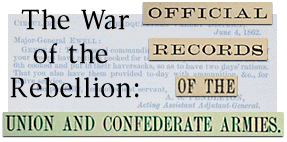Summary:
Union General Robert Milroy forwards the April, 1863, statement of a Confederate
prisoner to Robert Schenck. In the statement, the Confederate cavalryman gives
the locations and strengths of various Confederate forces. He reports A. P.
Hill's division moving to the Valley through Staunton.
Maj.-Gen. SCHENCK,
Baltimore, Md.:
WINCHESTER, VA.,
April 25, 1863.
Rebel Andrew T. Leopole, the last two days in irons, hoping for leniency, makes this statement:
Residence, Sharpsburg, Md. Enlisted in Confederate service two years ago, as ensign First Regt. Virginia (rebel) Cavalry, and remained in that regiment until Stuart's appointment as brigadier, about a month after the first battle of Manassas, when I became ensign of his brigade, which I continued to be until last May, when I was transferred to the-Virginia Cavalry as third lieutenant. I continued in that regiment until after the battle of Sharpsburg, in September last, when I was promoted to first lieutenant of Company D, same regiment, in which regiment I served until November 24 last, when I was captured at Shepherdstown. I remained a prisoner until January 6 last, when I was exchanged, and reported, as ordered, to Gen. Stuart, at this headquarters, where I remained until January 13, acting as his chief of couriers. On January 14, as ordered by him, I left for Castleman's Ferry, in command of 70 men, where I remained until last Tuesday, when, with 6 of my men, I was captured. My business there was to observe the movements of Federal forces, and report to Gen. Fitzhugh Lee, who is now between Markham Station and Manassas Gap Railroad and the Shenandoah River, about 2 miles east of the Blue Ridge, with the First, Second, Third, Fourth, Fifth, and Tenth Virginia Cavalry and two batteries. Regiments average about 350 men each. The locality of these troops is about 16 miles from Castleman's Ferry and 10 miles from Berry's Ferry. Gen. Trimble, with three infantry brigades, is near Orleans, in Fauquier County. Lee's and Trimble's forces moved at the same time from Culpeper Court-House to their present position, where they arrived about two days before my capture. There are two other brigades-one from Louisiana and the other from Virginia-encamped between Sperryville and Little Washington. They belong to Trimble's division. With each brigade is a battery, and a battalion of artillery besides, attached to the division. The brigades, I think, will average 1,900 men each. The two brigades near Sperryville came that far with the other brigades, and halted there. I saw Gen. Stuart on the 17th of this month between Salem and Jefferson, and learned from him that A. P. Hill, with a portion of his command, had left for the Valley by way of Hanover Junction, Charlottesville, and Staunton. I saw Hill's baggage at Culpeper, and learned from the master of transportation that it was en route from Staunton. I heard Gen. Stuart say that the Federal forces at Winchester would be captured as soon as the Shenandoah River became passable. I also learned form his general-order book that Jones had been ordered to march to the Baltimore and Ohio Railroad, and destroy certain trestle-work on that road. I am tired of fighting, and wish to take the oath of allegiance and retire into Ohio. I have always stood high with Gen. Stuart, enjoyed his confidence, and, when at his headquarters, ate at his table.
The above statement is strongly corroborated by other circumstances and information. I recommend that Heintzelman be directed to ascertain the truth of the above statement, so far as it refers to Fitzhugh Lee's and Trimble's forces and their locality.
R. H. MILROY,
Maj.-Gen.
Bibliographic Information : Letter Reproduced from The War of The Rebellion: Official Records of the Union and Confederate Armies, Series 1, Volume 25, Serial No. 40, Pages 252-253, Broadfoot Publishing Company, Wilmington, NC, 1997.

